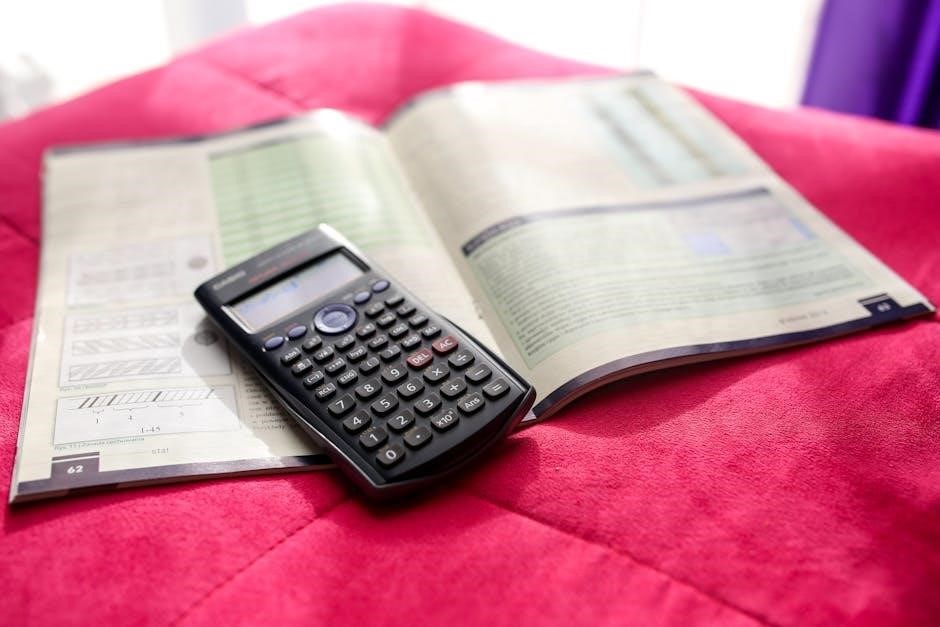Beast Academy books‚ created by Art of Problem Solving‚ provide a comprehensive math curriculum for grades 2-5. Available as PDF downloads‚ these engaging textbooks combine guidebooks‚ practice problems‚ and puzzles to foster advanced math skills in young learners.
1.1 Overview of Beast Academy Series
Beast Academy is a comprehensive math curriculum designed for students in grades 2-5‚ developed by Art of Problem Solving. The series combines engaging guidebooks‚ practice problems‚ and puzzle collections to create a rigorous yet fun learning experience. Each grade level is divided into four parts‚ covering topics like arithmetic‚ geometry‚ and algebra. The curriculum emphasizes problem-solving strategies and critical thinking‚ making it ideal for gifted students or those seeking a challenging math program. Available as PDF downloads‚ Beast Academy offers flexibility for homeschooling or supplemental learning‚ ensuring accessibility for diverse educational needs.
1.2 Importance of Math Education for Grades 2-5
Math education for grades 2-5 is crucial for building foundational skills that shape future academic success. Beast Academy books cater to this critical period‚ fostering advanced math understanding through engaging and challenging content. These grades lay the groundwork for problem-solving‚ critical thinking‚ and logical reasoning‚ essential for lifelong learning. By introducing rigorous concepts early‚ Beast Academy helps students develop confidence and a strong math foundation‚ preparing them for higher-level math and real-world applications. Its structured approach ensures young learners are well-equipped to tackle complex problems with creativity and precision.
1.3 Unique Features of Beast Academy Curriculum
Beast Academy’s curriculum stands out with its comic-style illustrations and engaging design‚ making math learning fun and accessible for grades 2-5. It offers a rigorous‚ challenging approach that fosters advanced problem-solving skills and critical thinking. The curriculum combines guidebooks for conceptual understanding‚ practice books for reinforcement‚ and puzzle collections for enjoyable learning. Additionally‚ Beast Academy provides a companion website with online resources‚ games‚ and interactive tools to enhance math education. These features create a comprehensive and engaging learning experience tailored to gifted students‚ ensuring they develop a deep understanding of math concepts.

Structure and Content of Beast Academy Books
Beast Academy books are structured into guidebooks‚ practice problems‚ and puzzle collections‚ offering a comprehensive curriculum for grades 2-5 with engaging‚ challenging content.
2.1 Grade-Specific Curriculum Breakdown
Beast Academy books are tailored for grades 2-5‚ with each grade divided into multiple parts (e.g.‚ 2A‚ 2B‚ 2C‚ 2D). Each part focuses on specific math concepts‚ ensuring a gradual progression from foundational skills to advanced topics. For instance‚ Grade 5 includes chapters on sequences‚ ratios‚ and decimals. The curriculum is designed to build upon previous knowledge‚ with guidebooks explaining concepts and practice books reinforcing learning through interactive problems and puzzles.
2.2 Key Topics Covered in Each Grade Level
Beast Academy books cover essential math topics tailored to each grade level‚ ensuring a well-rounded education. For example‚ lower grades focus on foundational concepts like geometry basics‚ while higher grades explore advanced topics such as ratios‚ rates‚ and decimals. Each grade-specific curriculum includes chapters designed to build upon previous knowledge‚ with engaging comic-style illustrations to maintain student interest. The books emphasize problem-solving strategies and critical thinking‚ preparing students for more complex mathematical challenges ahead.

2.3 Integration of Guidebooks and Practice Problems
Beast Academy combines guidebooks and practice problems to create a cohesive learning experience. Guidebooks introduce concepts through engaging narratives and comic-style visuals‚ while practice problems reinforce understanding. This integration ensures students grasp mathematical ideas before applying them to exercises. The structure aligns with grade-specific topics‚ allowing for a smooth progression from theory to practical application. This dual approach fosters deep comprehension and mastery‚ making math accessible and enjoyable for young learners.

Key Features of Beast Academy
Beast Academy features comic-style illustrations‚ engaging designs‚ and a structured approach to math learning. Its integration of guidebooks‚ practice problems‚ and online resources creates an interactive‚ fun experience for students.
3.1 Comic-Style Illustrations and Engaging Design
Beast Academy books feature vibrant‚ comic-style illustrations that captivate young learners‚ transforming complex math concepts into engaging adventures. The dynamic design‚ with colorful visuals and relatable characters like the “math beasts‚” makes problem-solving fun and accessible. Each chapter is presented in an entertaining narrative format‚ helping students connect emotionally with the material. These visual elements‚ combined with a structured curriculum‚ create an immersive learning experience. The PDF versions of these books retain their visual appeal‚ ensuring that digital users can enjoy the same engaging design as print readers. This unique approach fosters motivation and enjoyment in math education.
3.2 Companion Website and Online Resources

Beast Academy’s companion website‚ BeastAcademy.com‚ offers a wealth of online resources to complement its curriculum. Students and educators can access interactive tools‚ video lessons‚ and additional practice problems to reinforce learning. The website also provides games‚ printable activities‚ and PDF downloads‚ ensuring flexibility for diverse learning needs. These resources are designed to enhance engagement and understanding‚ making math education more dynamic and accessible. By integrating digital and print materials‚ Beast Academy creates a seamless learning experience that supports both in-class and at-home education.
3.3 Problem-Solving Strategies and Pedagogical Approach
Beast Academy employs a unique pedagogical approach focused on fostering advanced problem-solving skills. The curriculum emphasizes critical thinking‚ creativity‚ and logical reasoning through structured‚ challenging problems. Guidebooks introduce concepts with engaging comic-style narratives‚ while practice books reinforce learning. The approach encourages students to explore multiple solution paths‚ promoting resilience and innovation. By integrating puzzles and real-world applications‚ Beast Academy teaches math as a dynamic‚ problem-solving discipline‚ preparing students for complex challenges and nurturing a deep appreciation for mathematics.
How to Use Beast Academy Books
Use Beast Academy guidebooks for conceptual understanding‚ practice books for skill mastery‚ and puzzle collections for fun‚ reinforcing math concepts and fostering engagement in learning.
4.1 Guidebooks for Conceptual Understanding
Beast Academy guidebooks are designed to build a strong foundation in math through detailed explanations and visual aids. Each guidebook uses a comic-style format to present concepts in an engaging and accessible way‚ making complex ideas easier to grasp for young learners. Topics are broken down into manageable chapters‚ such as Numbers and Place Value‚ Shapes‚ and Data‚ ensuring a logical progression of skills. The guidebooks are tailored for grades 2-5 and are available as PDF downloads‚ allowing students to explore math concepts at their own pace. This approach encourages deep understanding and prepares students for practical application in real-world challenges.
4.2 Practice Books for Reinforcement and Mastery
Beast Academy practice books complement the guidebooks by offering extensive problem sets to reinforce learning. Each grade level includes four practice books‚ aligning with the guidebooks’ content. Problems range from basic drills to challenging puzzles‚ ensuring mastery of concepts like arithmetic‚ geometry‚ and data analysis. The exercises are designed to improve computational skills‚ logical thinking‚ and problem-solving strategies. Available as PDF downloads‚ these practice books provide flexibility for students to work independently. They are structured to build confidence and fluency‚ preparing learners for advanced math challenges while maintaining engagement through varied and stimulating activities.
4.3 Incorporating Puzzle Collections for Fun Learning
Beast Academy Puzzle Collections add an exciting dimension to math learning‚ blending fun with intellectual challenges. These puzzles‚ available as PDF downloads‚ are designed to reinforce mathematical concepts through engaging brain teasers and games. Students can explore mazes‚ logic grids‚ and riddles that tie into the curriculum‚ making learning enjoyable and interactive. The puzzles cater to diverse learning styles‚ fostering creativity and critical thinking while maintaining alignment with the Beast Academy curriculum. They serve as a motivational tool‚ encouraging students to approach math with enthusiasm and confidence‚ even as they tackle complex problems.
Availability and Access to Beast Academy Books
Beast Academy books are available as PDF downloads‚ offering convenient access to guidebooks‚ practice problems‚ and puzzle collections. Visit BeastAcademy.com for digital resources and free printables.
5.1 PDF Downloads and Digital Access

Beast Academy books are conveniently available as PDF downloads‚ offering easy access to guidebooks‚ practice problems‚ and puzzle collections. Parents and educators can download these resources directly from the official website‚ ensuring flexibility for both in-person and remote learning. Digital access also includes companion materials‚ such as interactive tools and printable activities‚ to enhance the learning experience. The PDF format allows for easy organization and portability‚ making it simple to integrate Beast Academy’s curriculum into any educational setting. This digital accessibility ensures that students can engage with advanced math content anytime‚ anywhere‚ promoting consistent and enjoyable learning.

5.2 Purchase Options and Bulk Discounts
Beast Academy books are available for purchase in various formats‚ including PDF downloads and physical copies. Parents and educators can buy individual books or sets‚ with options for bulk discounts. Buying five or more copies of a single title offers a 10% discount‚ while purchasing ten or more copies provides a 20% discount. These bulk options are ideal for schools or homeschooling groups. Additionally‚ online retailers like Amazon offer Beast Academy books‚ making them easily accessible. The official website also provides purchase options‚ ensuring a seamless buying experience for all customers.
5.3 Free Printable Activities and Resources
Beast Academy offers a variety of free printable activities and resources to supplement its curriculum. These include puzzle collections‚ practice problems‚ and enrichment materials designed to enhance math learning. Parents and educators can download PDFs of these activities‚ providing students with engaging‚ fun‚ and challenging exercises. Additionally‚ the official Beast Academy website features downloadable resources such as games and interactive tools to support advanced math skills. These free materials are perfect for reinforcing concepts taught in the guidebooks and practice books‚ making them an invaluable addition to any math education program.
Benefits of Beast Academy for Students
Beast Academy fosters advanced math skills‚ enhances problem-solving abilities‚ and encourages critical thinking. Its engaging design and resources keep students motivated and eager to learn mathematics.

6.1 Development of Advanced Math Skills
Beast Academy books are designed to cultivate advanced math skills in students through a comprehensive and structured curriculum. The guidebooks provide detailed explanations of complex mathematical concepts‚ while practice books offer exercises to apply these skills. Puzzle collections introduce challenging problems that encourage deeper understanding and mastery. The curriculum is tailored to build proficiency in areas like sequences‚ ratios‚ and decimals‚ ensuring students develop a strong foundation for higher-level math. Available as PDF downloads‚ these resources make advanced learning accessible and engaging for young scholars.
6.2 Building Problem-Solving and Critical Thinking
Beast Academy books are designed to foster problem-solving and critical thinking through engaging‚ challenging math problems. The curriculum emphasizes analytical thinking‚ encouraging students to approach complex concepts methodically. Guidebooks and practice books provide structured exercises that promote logical reasoning and creativity. Puzzle collections add an element of fun while sharpening problem-solving skills. Available as PDF downloads‚ these resources offer a comprehensive learning experience that helps students develop strong critical thinking abilities‚ essential for tackling advanced math challenges with confidence and precision.
6.3 Encouraging Engagement and Motivation in Math
Beast Academy books captivate young learners with comic-style illustrations and engaging storylines‚ making math enjoyable and relatable. The curriculum’s interactive approach‚ combined with challenging yet achievable problems‚ fosters a sense of accomplishment. Guidebooks and practice books are designed to build confidence‚ while puzzle collections add an element of fun. Available as PDF downloads‚ these resources cater to diverse learning styles‚ ensuring students stay motivated and eager to explore mathematical concepts. By blending creativity with rigorous instruction‚ Beast Academy inspires a lifelong love for math and learning.

Additional Resources and Support
Beast Academy offers free printable activities‚ interactive games‚ and a companion website with digital resources‚ enhancing the learning experience for students and educators alike.
7.1 Printable Activities for Enrichment
Beast Academy offers a variety of free printable activities designed to enrich math learning for gifted students. These resources include puzzles‚ games‚ and exercises that align with the curriculum‚ providing additional challenges for advanced learners. The activities are crafted to be engaging and fun‚ helping students develop problem-solving skills and critical thinking. They are available as PDF downloads‚ making them easily accessible for parents and educators. These printable materials complement the Beast Academy books‚ offering a hands-on approach to math education that fosters creativity and deepens understanding of key concepts.

7.2 Games and Interactive Learning Tools
Beast Academy enhances math education with interactive games and tools that make learning engaging and fun. These resources‚ often available as PDF downloads or online‚ include puzzles‚ logic grids‚ and problem-solving challenges. Designed to complement the curriculum‚ they encourage students to think creatively and develop advanced math skills. The games are tailored for grades 2-5‚ offering a playful way to master concepts. By integrating these tools‚ Beast Academy creates a dynamic learning environment that motivates students and helps them excel in mathematics with enthusiasm and confidence.
7.3 Community and Support for Parents and Educators
Beast Academy offers a robust support system for parents and educators‚ ensuring successful implementation of its curriculum. The companion website provides access to forums‚ webinars‚ and downloadable resources‚ fostering a collaborative community. Educators can share strategies and materials‚ while parents gain insights into their child’s progress. Additional PDF guides and lesson plans are available‚ catering to diverse teaching styles. This comprehensive support network empowers educators and parents to create an effective and engaging learning environment‚ maximizing the benefits of the Beast Academy curriculum for their students.
Beast Academy books offer a comprehensive‚ engaging math curriculum for grades 2-5‚ fostering critical thinking and advanced skills. Their accessibility as PDFs makes them a valuable resource for educators and parents.
8.1 Summary of Beast Academy’s Value
Beast Academy books provide a rigorous and engaging math curriculum for grades 2-5‚ blending comic-style storytelling with challenging problems. Their unique blend fosters advanced math skills and logical thinking. Available as PDFs‚ the guidebooks and practice materials are easily accessible‚ making them a valuable tool for educators and parents seeking to enrich math education. The combination of conceptual understanding and practical exercises ensures a well-rounded learning experience‚ preparing students for future academic challenges while maintaining a fun and interactive approach to mathematics.
8.2 Final Thoughts on Implementing the Curriculum
Beast Academy books offer a comprehensive‚ engaging‚ and effective math curriculum for grades 2-5. Their unique approach‚ combining guidebooks‚ practice problems‚ and puzzles‚ ensures a deep understanding of mathematical concepts. The availability of PDF downloads and online resources makes implementation flexible and accessible for educators and parents. By fostering advanced skills and problem-solving strategies‚ Beast Academy prepares students for future academic success while maintaining a fun and interactive learning experience. This curriculum is a valuable tool for any math education setting‚ providing a structured yet versatile approach to nurturing young math enthusiasts.


























































































